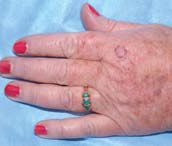Skin Cancer: How To Recognize Pre-Malignant Symptoms Before It's Too Late [SLIDESHOW]
An actinic keratosis, also known as a solar keratosis, is a very common, sun-induced scaly or crusty growth (lesion). These are not simple "age spots" but something more; many years of exposure to the ultraviolet radiation of the sun has caused genetic changes in your keratinocytes, the most common form of a cell in your outermost layer of skin. Actinic keratosis indicates that you have sustained sun damage.
Most often the plural, "keratoses," is used to describe these lesions, because seldom is there just one. Actinic keratoses most often appears on the backs of the hands and forearms, a bald scalp, face, ears, lips, shoulders, neck, or any other areas of the body frequently exposed to the sun.
Although most individual lesions do not become invasive cancers, the majority of invasive squamous cell carcinomas (a type of treatable skin cancer) originate from actinic keratoses. Genetic analysis demonstrates that ultraviolet radiation-induced mutations and changes in gene expression are present in squamous cell carcinoma, actinic keratoses, and normal-appearing sun-exposed skin; the nature of keratinocyte transformation, then, is clearly progressive.
Actinic keratoses often start small or, in the case of subclinical lesions below the surface, they are not even visible, though they may be recognized by touch; the feeling is that of running a finger over sandpaper. Most often, actinic keratoses develop until they reach a size from an eighth to a quarter of an inch. They may disappear only to reappear later. Most become red, but some will be light or dark tan, pink, red, a combination of these, or simply skin-colored. Occasionally they itch or become inflamed. Rarely, actinic keratoses may bleed.
The presence of certain features, such as large size, ulceration, or bleeding, suggests an increased risk of disease progression. Such a risk would be increased by evidence of extensive solar damage, advanced age, and immunosuppression. Early diagnosis and consideration for treatment are indicated to clear actinically damaged sites and diminish the risk of invasive squamous cell carcinoma.
When it is necessary to treat actinic keratoses, they are treated with both individual lesion and field-directed methods. Field-directed methods would mean treating the entire "cancer field," both the visible and subclinical lesions present in photodamaged skin. Medicated creams and solutions are also often effective in the treatment of skin cancer.
Source: Martin G, Swanson N. Clinical findings using ingenol mebutate gel to treat actinic keratoses. Journal of the American Academy of Dermatology. 2013.

































